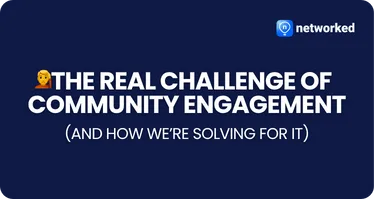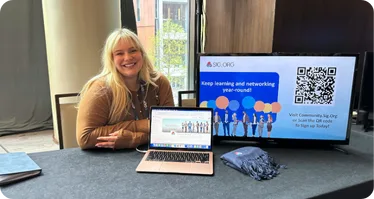In today’s digital age, building a strong community around your personal brand is more important than ever. For creators, coaches, and consultants, a community is more than just a group of followers—it’s a dedicated space where your audience can connect, share experiences, and grow together. But how do you build a community that thrives and helps your personal brand reach new heights?

In this guide, we’ll walk through the key steps to build a thriving brand community that not only engages your audience but also drives growth and loyalty for your business.
A Community Around Your Personal Brand
A brand community is a space where people with a shared interest in your personal brand come together. This space can exist online or offline, but the goal is always the same: to foster meaningful interactions between you and your audience. Whether they are clients, customers, or simply brand enthusiasts, community members gain value from each other’s insights, feedback, and shared experiences.
An effective brand community strengthens loyalty, creates ambassadors for your brand, and provides a platform for consistent engagement. But it’s not just about you—it’s about creating a valuable space where your audience can connect with one another.
Why Build a Community Around Your Personal Brand?
1. Deeper Engagement and Connection
Building a community around your brand creates a two-way dialogue with your audience. It’s not just you talking to them—it’s them talking to each other, exchanging ideas, and strengthening their relationship with your brand. This deeper engagement results in higher loyalty and long-term relationships.
2. Valuable Feedback
When you create a space where your audience feels comfortable, they’re more likely to share honest feedback. This feedback is gold—it helps you improve your services, products, or content based on real user insights.
3. Reduced Customer Support
A well-functioning community can help reduce your need for one-on-one customer support. Your members will help each other, answer questions, and share their experiences—saving you time and effort while ensuring your community feels heard.
4. Increased Brand Visibility
Your community members become your most vocal supporters. As they engage with your brand, they’re likely to share their experiences with others—whether through word-of-mouth, social media, or other platforms. This organic reach helps you grow your brand and attract new members.
Step 1: Identify Your Ideal Community Members
Before you start building your community, you need to understand who you’re building it for. Your ideal community members are the people who align with your brand’s values, vision, and goals. Here’s how to define them:
Demographics: Who are they? What’s their age, location, or profession? Understanding their basic demographics will help you shape the tone and style of your community.
Interests and Pain Points: What challenges do they face? What are they passionate about? Knowing this will help you tailor content and discussions that provide real value.
Motivation for Joining: Why would they join your community? Are they looking for exclusive content, networking opportunities, or support? Clarifying this helps set expectations and positions your community as the solution to their needs.
Step 2: Choose the Right Platform
Selecting the right platform is crucial for building a thriving community. Your choice depends on the type of experience you want to create:
Social Media Groups: Facebook Groups and LinkedIn Groups offer large audiences and easy accessibility. However, they come with limited branding options and can be distracting due to other platform activities.
Dedicated Community Platforms: If you want more control, a dedicated community platform like Networked allows you to create a branded experience. Here, you can set custom rules, manage content, and offer members exclusive perks.
Forums and Private Membership Sites: For a more niche and intimate community, consider using a forum or a private membership site. These options offer higher engagement but require more management and upkeep.
The key is to choose a platform that aligns with your goals and makes it easy for members to engage with each other and your brand.
Step 3: Create a Community Framework
Building a community isn’t just about attracting members—it’s about creating a structure that keeps them engaged. Here are the elements you should focus on:
1. Set Clear Goals
What is the purpose of your community? Whether it’s to provide support, offer exclusive content, or create a learning environment, having a clear goal ensures that your community serves both you and your members effectively.
2. Establish Guidelines
Community guidelines are essential for maintaining a positive and respectful environment. Set clear rules on what’s acceptable behavior, how to participate, and what types of content are encouraged. Make these guidelines visible from the moment someone joins.
3. Encourage Participation
Create opportunities for your members to get involved. Ask open-ended questions, organize challenges, and create discussion threads that invite feedback. The more you encourage participation, the more engaged and invested your community members will be.
Step 4: Promote Your Community
Once your community is set up, it’s time to invite members.
Here are some promotion strategies to help you get started:
Leverage Your Existing Audience: If you already have an email list, social media followers, or clients, invite them to join your community. Make it clear why they should join and what value they’ll get from being a member.
Offer Exclusive Perks: Incentivize people to join by offering early access to content, special discounts, or members-only events. These perks make your community more desirable.
Word-of-Mouth Referrals: Encourage your existing members to invite others. People are more likely to join when they see their peers are already part of the group.
Step 5: Keep Your Community Engaged
Getting people to join your community is just the beginning. The real work lies in keeping them engaged over time. Here are some tips to keep your community active and thriving:
1. Plan and Schedule Content
Create a content calendar with regular posts, discussion topics, and events. Make sure the content is relevant to your audience’s interests and goals. Posting consistently keeps your community members engaged and gives them a reason to return.
2. Recognize and Celebrate Members
Celebrate milestones, achievements, and contributions from your community members. Whether it’s highlighting a success story or simply thanking them for their participation, this recognition builds loyalty and encourages others to engage.
3. Host Live Events
Organize live events such as Q&A sessions, workshops, or webinars. These events offer real-time interaction and deepen the relationship between you and your members. Live events also create excitement and anticipation, making your community feel more dynamic.
4. Create User-Generated Content Opportunities
Encourage members to create their own content within the community. This could be sharing success stories, posting their own questions, or offering advice to other members. User-generated content fosters a sense of ownership and makes members feel like they are contributing to something bigger.
Final Thoughts
Building a thriving community around your personal brand takes time and effort, but the rewards are well worth it. A strong, engaged community not only strengthens your brand but also fosters loyalty, trust, and long-term growth.
By following these steps—defining your audience, choosing the right platform, creating a structured framework, and keeping your community engaged—you’ll be well on your way to building a successful brand community that stands the test of time.
So, start building today and watch your community grow into a powerful asset for your personal brand!




